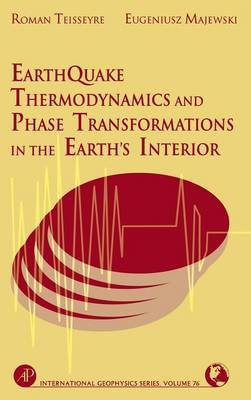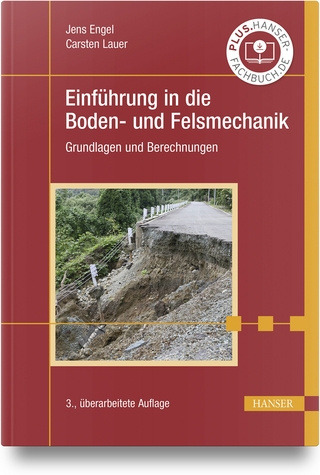
Earthquake Thermodynamics and Phase Transformation in the Earth's Interior
Seiten
2000
Academic Press Inc (Verlag)
978-0-12-685185-4 (ISBN)
Academic Press Inc (Verlag)
978-0-12-685185-4 (ISBN)
- Titel ist leider vergriffen;
keine Neuauflage - Artikel merken
What triggers earthquakes? There are a plethora of research theories examining this important societal question. This edited treatise examines various geophysical processes centred around earthquake thermodynamics and phase transformations as triggering mechanisms to earthquakes.
A group of distinguished scientists contributes to the foundations of a new discipline in Earth sciences: earthquake thermodynamics and thermodynamics of formation of the Earth's interior structures. The predictive powers of thermodynamics are so great that those aspiring to model earthquake and the Earth's interior will certainly wish to be able to use the theory. Thermodynamics is our only method of understanding and predicting the behavior of many environmental, atmospheric, and geological processes. The need for Earth scientists to develop a functional knowledge of thermodynamic concepts and methodology is therefore urgent. Sources of an entropy increase the dissipative and self-organizing systems driving the evolution and dynamics of the Universe and Earth through irreversible processes. The non-linear interactions lead to the formation of fractal structures. From the structural phase transformations the important interior boundaries emerge.Non-linear interactions between the defects in solids lead the authors to develop the physics of continua with a dense distribution of defects. Disclinations and dislocations interact during a slow evolution as well as during rapid dynamic events, like earthquakes. Splitting the dynamic processes into the 2D fault done and 3D surrounding space brings a new tool for describing the slip nucleation and propagation along the earthquake faults. Seismic efficiency, rupture velocity, and complexity of seismic source zone are considered from different points of view, fracture band earthquake model is developed on the basis of thermodynamics of line defects, like dislocations. Earthquake thermodynamics offers us a microscopic model of earthquake sources.Physics of defects helps the authors decscribe and explain a number of precursory phenomena caused by the buildup of stresses. Anomalies in electric polarization and electromagnetic radiation prior to earthquakes are considered from this point of view. Through the thermodynamic approach, the authors arrive at the fascinating question of posssibility of earthquake prediction. In general, the Earth is considered here as a multicomponent system. Transport phenomena as well as wave propagation and shock waves are considered in this system subjected also to chemical and phase transformations.
A group of distinguished scientists contributes to the foundations of a new discipline in Earth sciences: earthquake thermodynamics and thermodynamics of formation of the Earth's interior structures. The predictive powers of thermodynamics are so great that those aspiring to model earthquake and the Earth's interior will certainly wish to be able to use the theory. Thermodynamics is our only method of understanding and predicting the behavior of many environmental, atmospheric, and geological processes. The need for Earth scientists to develop a functional knowledge of thermodynamic concepts and methodology is therefore urgent. Sources of an entropy increase the dissipative and self-organizing systems driving the evolution and dynamics of the Universe and Earth through irreversible processes. The non-linear interactions lead to the formation of fractal structures. From the structural phase transformations the important interior boundaries emerge.Non-linear interactions between the defects in solids lead the authors to develop the physics of continua with a dense distribution of defects. Disclinations and dislocations interact during a slow evolution as well as during rapid dynamic events, like earthquakes. Splitting the dynamic processes into the 2D fault done and 3D surrounding space brings a new tool for describing the slip nucleation and propagation along the earthquake faults. Seismic efficiency, rupture velocity, and complexity of seismic source zone are considered from different points of view, fracture band earthquake model is developed on the basis of thermodynamics of line defects, like dislocations. Earthquake thermodynamics offers us a microscopic model of earthquake sources.Physics of defects helps the authors decscribe and explain a number of precursory phenomena caused by the buildup of stresses. Anomalies in electric polarization and electromagnetic radiation prior to earthquakes are considered from this point of view. Through the thermodynamic approach, the authors arrive at the fascinating question of posssibility of earthquake prediction. In general, the Earth is considered here as a multicomponent system. Transport phenomena as well as wave propagation and shock waves are considered in this system subjected also to chemical and phase transformations.
Renata Dmowska works in the School of Engineering and Applied Sciences at Harvard University in Cambridge, MA, USA. James R. Holton was Professor of Atmospheric Sciences at the University of Washington until his death in 2004. A member of the National Academies of Science, during his career he was awarded every major honor available in the atmospheric sciences including AGU’s Revelle Medal.
| Erscheint lt. Verlag | 19.10.2000 |
|---|---|
| Reihe/Serie | International Geophysics |
| Mitarbeit |
Herausgeber (Serie): Renata Dmowska, James R. Holton |
| Verlagsort | San Diego |
| Sprache | englisch |
| Maße | 152 x 229 mm |
| Gewicht | 1020 g |
| Themenwelt | Naturwissenschaften ► Geowissenschaften ► Geologie |
| Naturwissenschaften ► Physik / Astronomie ► Thermodynamik | |
| ISBN-10 | 0-12-685185-9 / 0126851859 |
| ISBN-13 | 978-0-12-685185-4 / 9780126851854 |
| Zustand | Neuware |
| Haben Sie eine Frage zum Produkt? |
Mehr entdecken
aus dem Bereich
aus dem Bereich
Grundlagen und Berechnungen
Buch | Hardcover (2022)
Hanser (Verlag)
CHF 55,95


